Research Report: Artificial Intelligence in Business Analysis
VerifiedAdded on 2020/03/16
|19
|2868
|60
Report
AI Summary
This report presents a business research study on artificial intelligence (AI), exploring its applications and impact across various sectors. The research delves into the benefits of AI, such as improved efficiency, enhanced research capabilities, and continuous operation, while also addressing challenges like high implementation costs and potential job displacement. The study encompasses both qualitative and quantitative research methodologies, including literature reviews, research questions, and a time schedule. It examines AI's role in diverse industries like Google, Apple, and the medical field, highlighting its potential for ocean floor and Mars exploration, and also discusses its use in predicting future organizational performance. The report concludes with a discussion of research limitations and a detailed time schedule for the project, offering valuable insights into the current and future landscape of AI in business.
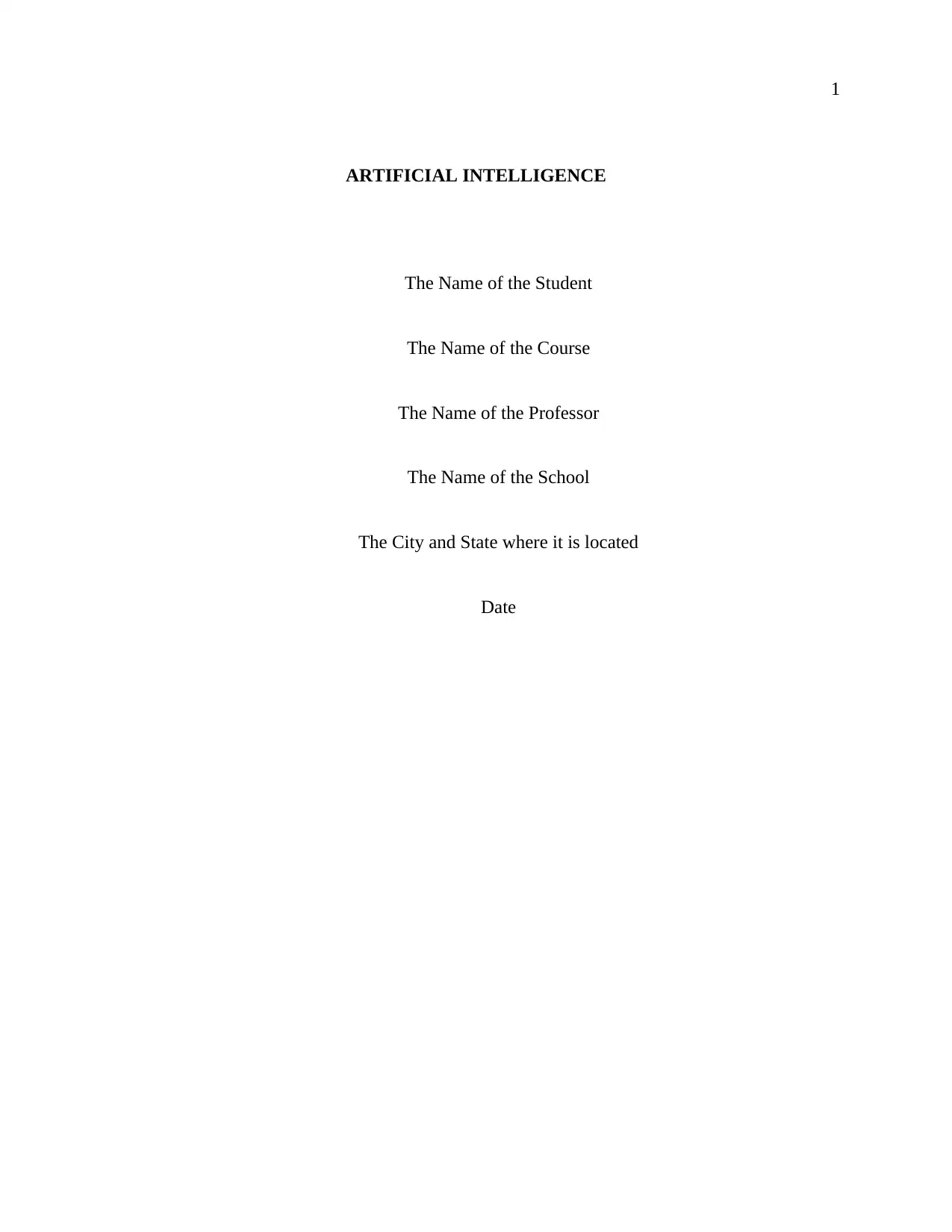
1
ARTIFICIAL INTELLIGENCE
The Name of the Student
The Name of the Course
The Name of the Professor
The Name of the School
The City and State where it is located
Date
ARTIFICIAL INTELLIGENCE
The Name of the Student
The Name of the Course
The Name of the Professor
The Name of the School
The City and State where it is located
Date
Paraphrase This Document
Need a fresh take? Get an instant paraphrase of this document with our AI Paraphraser
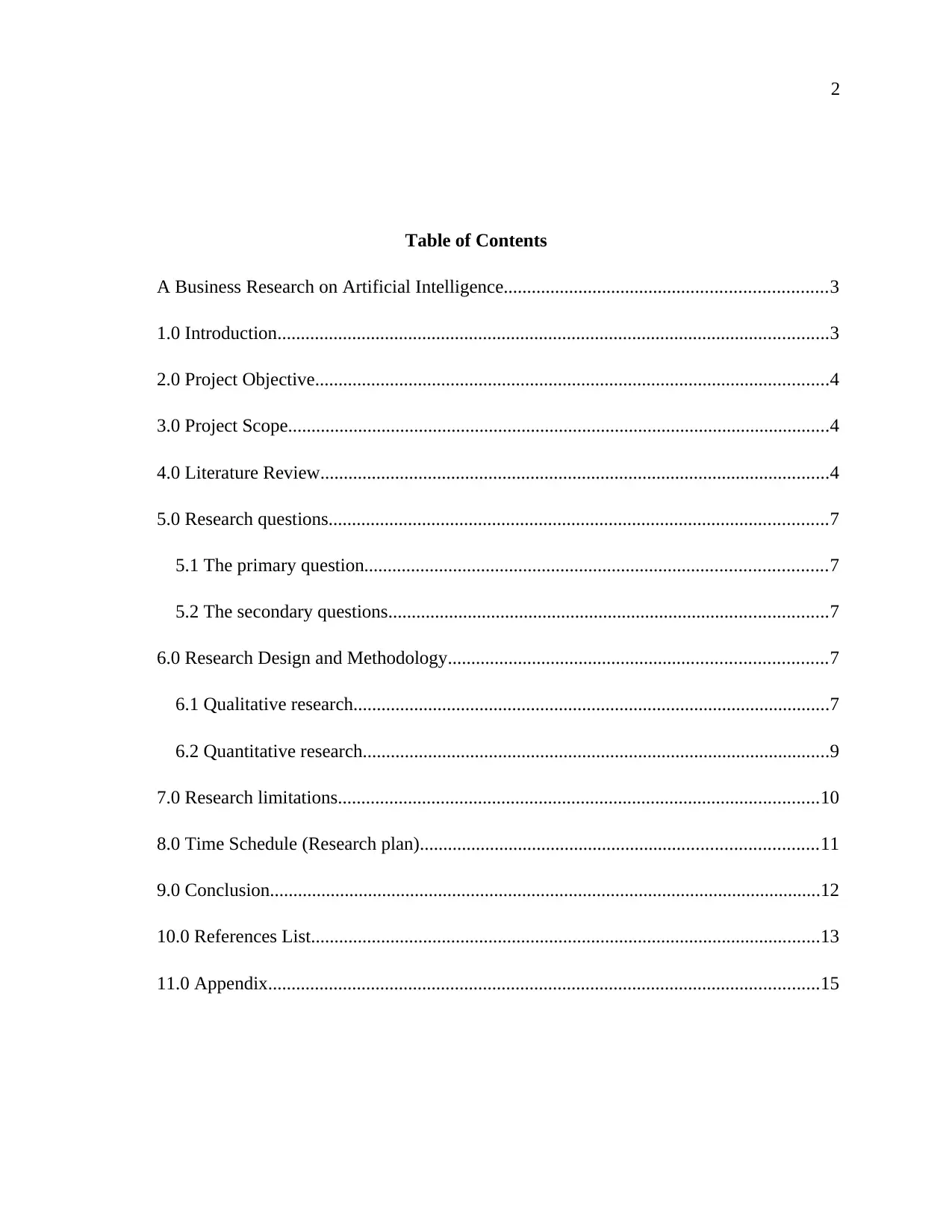
2
Table of Contents
A Business Research on Artificial Intelligence.....................................................................3
1.0 Introduction......................................................................................................................3
2.0 Project Objective..............................................................................................................4
3.0 Project Scope....................................................................................................................4
4.0 Literature Review.............................................................................................................4
5.0 Research questions...........................................................................................................7
5.1 The primary question...................................................................................................7
5.2 The secondary questions..............................................................................................7
6.0 Research Design and Methodology.................................................................................7
6.1 Qualitative research......................................................................................................7
6.2 Quantitative research....................................................................................................9
7.0 Research limitations.......................................................................................................10
8.0 Time Schedule (Research plan).....................................................................................11
9.0 Conclusion......................................................................................................................12
10.0 References List.............................................................................................................13
11.0 Appendix......................................................................................................................15
Table of Contents
A Business Research on Artificial Intelligence.....................................................................3
1.0 Introduction......................................................................................................................3
2.0 Project Objective..............................................................................................................4
3.0 Project Scope....................................................................................................................4
4.0 Literature Review.............................................................................................................4
5.0 Research questions...........................................................................................................7
5.1 The primary question...................................................................................................7
5.2 The secondary questions..............................................................................................7
6.0 Research Design and Methodology.................................................................................7
6.1 Qualitative research......................................................................................................7
6.2 Quantitative research....................................................................................................9
7.0 Research limitations.......................................................................................................10
8.0 Time Schedule (Research plan).....................................................................................11
9.0 Conclusion......................................................................................................................12
10.0 References List.............................................................................................................13
11.0 Appendix......................................................................................................................15
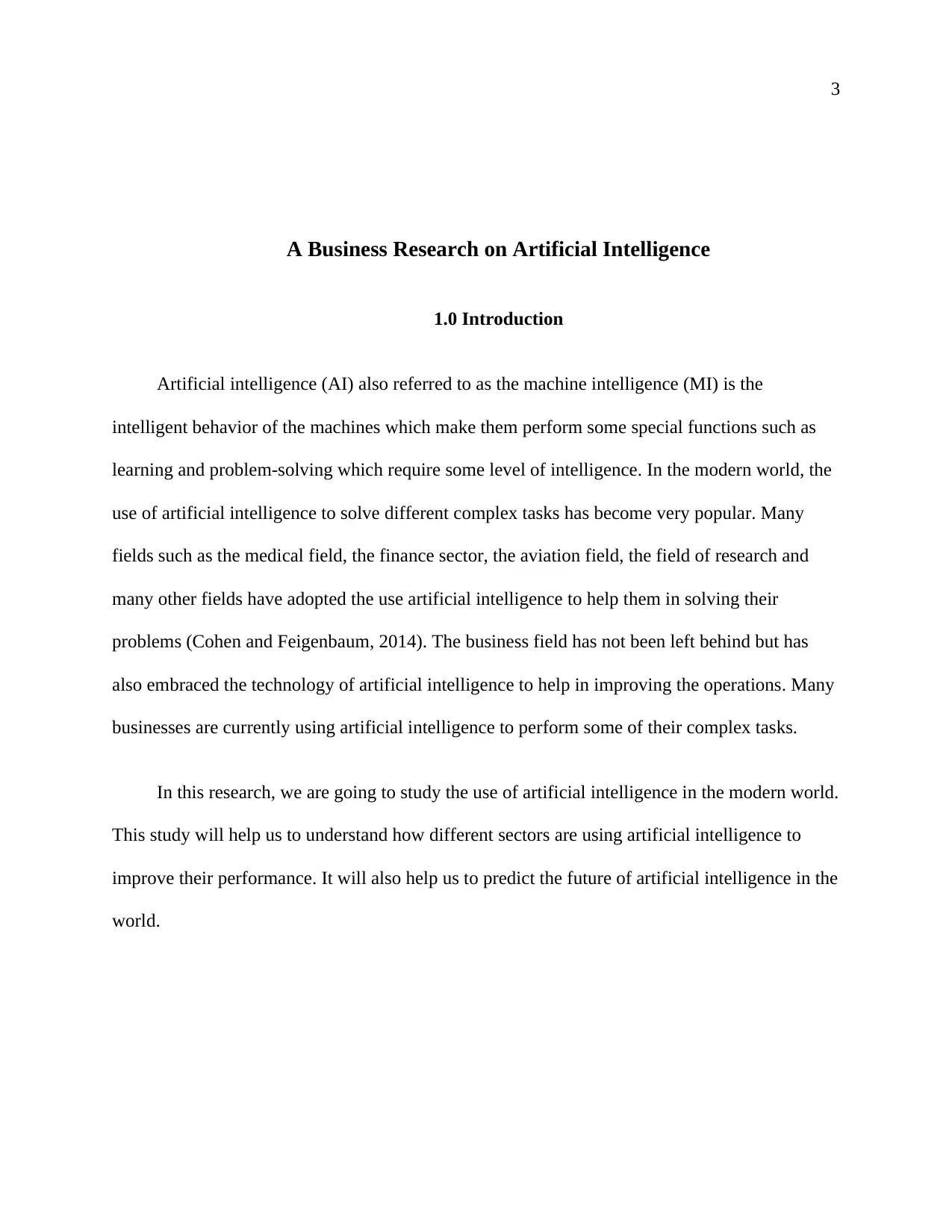
3
A Business Research on Artificial Intelligence
1.0 Introduction
Artificial intelligence (AI) also referred to as the machine intelligence (MI) is the
intelligent behavior of the machines which make them perform some special functions such as
learning and problem-solving which require some level of intelligence. In the modern world, the
use of artificial intelligence to solve different complex tasks has become very popular. Many
fields such as the medical field, the finance sector, the aviation field, the field of research and
many other fields have adopted the use artificial intelligence to help them in solving their
problems (Cohen and Feigenbaum, 2014). The business field has not been left behind but has
also embraced the technology of artificial intelligence to help in improving the operations. Many
businesses are currently using artificial intelligence to perform some of their complex tasks.
In this research, we are going to study the use of artificial intelligence in the modern world.
This study will help us to understand how different sectors are using artificial intelligence to
improve their performance. It will also help us to predict the future of artificial intelligence in the
world.
A Business Research on Artificial Intelligence
1.0 Introduction
Artificial intelligence (AI) also referred to as the machine intelligence (MI) is the
intelligent behavior of the machines which make them perform some special functions such as
learning and problem-solving which require some level of intelligence. In the modern world, the
use of artificial intelligence to solve different complex tasks has become very popular. Many
fields such as the medical field, the finance sector, the aviation field, the field of research and
many other fields have adopted the use artificial intelligence to help them in solving their
problems (Cohen and Feigenbaum, 2014). The business field has not been left behind but has
also embraced the technology of artificial intelligence to help in improving the operations. Many
businesses are currently using artificial intelligence to perform some of their complex tasks.
In this research, we are going to study the use of artificial intelligence in the modern world.
This study will help us to understand how different sectors are using artificial intelligence to
improve their performance. It will also help us to predict the future of artificial intelligence in the
world.
⊘ This is a preview!⊘
Do you want full access?
Subscribe today to unlock all pages.

Trusted by 1+ million students worldwide
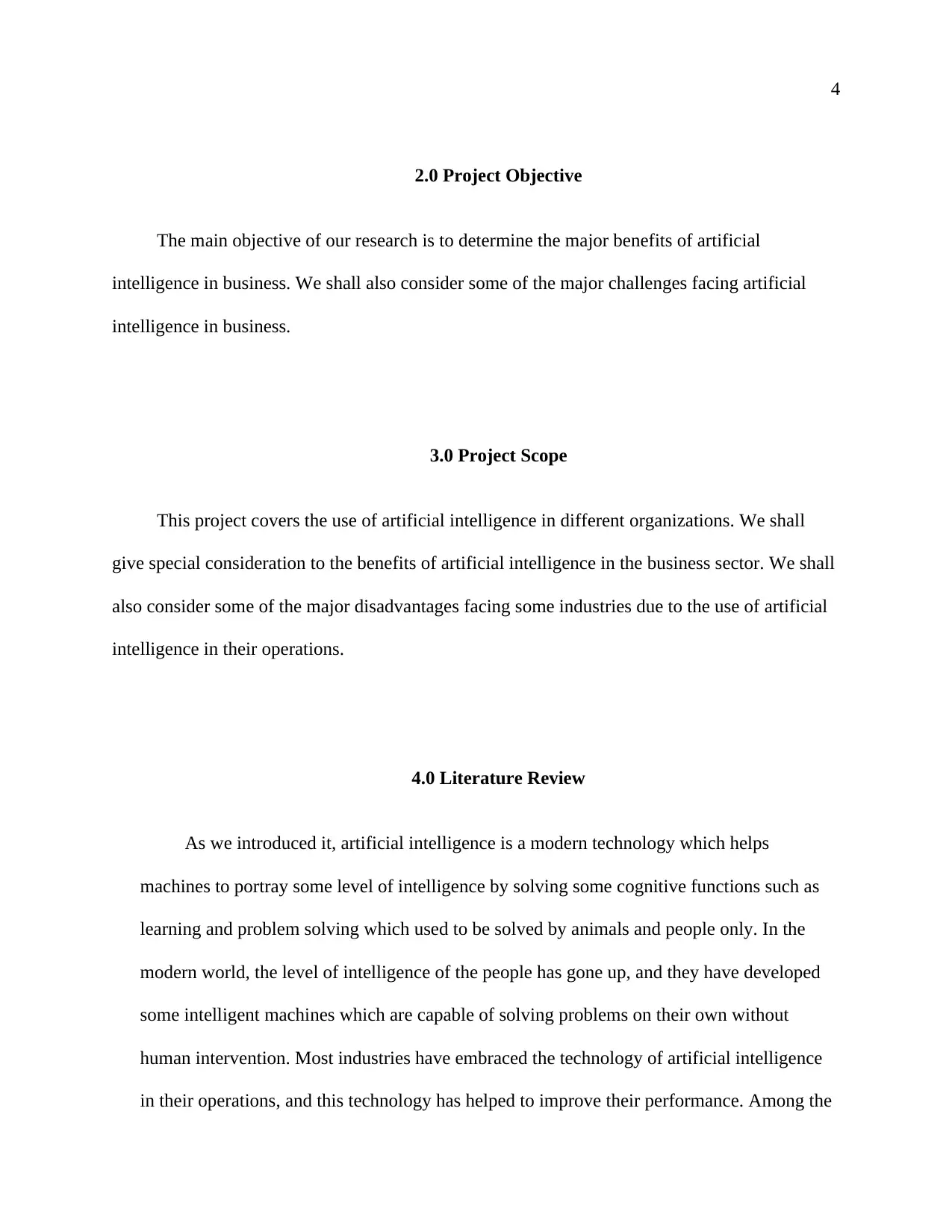
4
2.0 Project Objective
The main objective of our research is to determine the major benefits of artificial
intelligence in business. We shall also consider some of the major challenges facing artificial
intelligence in business.
3.0 Project Scope
This project covers the use of artificial intelligence in different organizations. We shall
give special consideration to the benefits of artificial intelligence in the business sector. We shall
also consider some of the major disadvantages facing some industries due to the use of artificial
intelligence in their operations.
4.0 Literature Review
As we introduced it, artificial intelligence is a modern technology which helps
machines to portray some level of intelligence by solving some cognitive functions such as
learning and problem solving which used to be solved by animals and people only. In the
modern world, the level of intelligence of the people has gone up, and they have developed
some intelligent machines which are capable of solving problems on their own without
human intervention. Most industries have embraced the technology of artificial intelligence
in their operations, and this technology has helped to improve their performance. Among the
2.0 Project Objective
The main objective of our research is to determine the major benefits of artificial
intelligence in business. We shall also consider some of the major challenges facing artificial
intelligence in business.
3.0 Project Scope
This project covers the use of artificial intelligence in different organizations. We shall
give special consideration to the benefits of artificial intelligence in the business sector. We shall
also consider some of the major disadvantages facing some industries due to the use of artificial
intelligence in their operations.
4.0 Literature Review
As we introduced it, artificial intelligence is a modern technology which helps
machines to portray some level of intelligence by solving some cognitive functions such as
learning and problem solving which used to be solved by animals and people only. In the
modern world, the level of intelligence of the people has gone up, and they have developed
some intelligent machines which are capable of solving problems on their own without
human intervention. Most industries have embraced the technology of artificial intelligence
in their operations, and this technology has helped to improve their performance. Among the
Paraphrase This Document
Need a fresh take? Get an instant paraphrase of this document with our AI Paraphraser
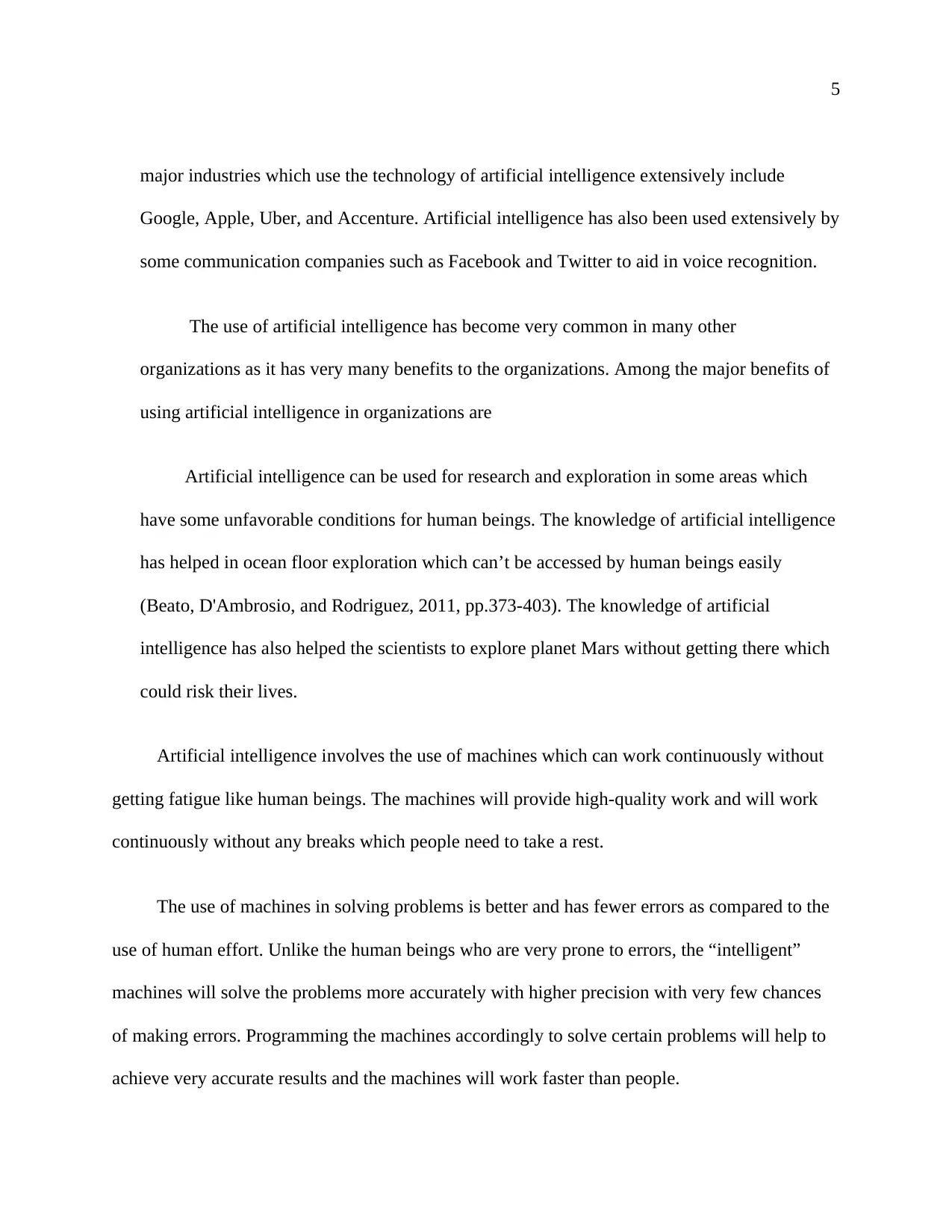
5
major industries which use the technology of artificial intelligence extensively include
Google, Apple, Uber, and Accenture. Artificial intelligence has also been used extensively by
some communication companies such as Facebook and Twitter to aid in voice recognition.
The use of artificial intelligence has become very common in many other
organizations as it has very many benefits to the organizations. Among the major benefits of
using artificial intelligence in organizations are
Artificial intelligence can be used for research and exploration in some areas which
have some unfavorable conditions for human beings. The knowledge of artificial intelligence
has helped in ocean floor exploration which can’t be accessed by human beings easily
(Beato, D'Ambrosio, and Rodriguez, 2011, pp.373-403). The knowledge of artificial
intelligence has also helped the scientists to explore planet Mars without getting there which
could risk their lives.
Artificial intelligence involves the use of machines which can work continuously without
getting fatigue like human beings. The machines will provide high-quality work and will work
continuously without any breaks which people need to take a rest.
The use of machines in solving problems is better and has fewer errors as compared to the
use of human effort. Unlike the human beings who are very prone to errors, the “intelligent”
machines will solve the problems more accurately with higher precision with very few chances
of making errors. Programming the machines accordingly to solve certain problems will help to
achieve very accurate results and the machines will work faster than people.
major industries which use the technology of artificial intelligence extensively include
Google, Apple, Uber, and Accenture. Artificial intelligence has also been used extensively by
some communication companies such as Facebook and Twitter to aid in voice recognition.
The use of artificial intelligence has become very common in many other
organizations as it has very many benefits to the organizations. Among the major benefits of
using artificial intelligence in organizations are
Artificial intelligence can be used for research and exploration in some areas which
have some unfavorable conditions for human beings. The knowledge of artificial intelligence
has helped in ocean floor exploration which can’t be accessed by human beings easily
(Beato, D'Ambrosio, and Rodriguez, 2011, pp.373-403). The knowledge of artificial
intelligence has also helped the scientists to explore planet Mars without getting there which
could risk their lives.
Artificial intelligence involves the use of machines which can work continuously without
getting fatigue like human beings. The machines will provide high-quality work and will work
continuously without any breaks which people need to take a rest.
The use of machines in solving problems is better and has fewer errors as compared to the
use of human effort. Unlike the human beings who are very prone to errors, the “intelligent”
machines will solve the problems more accurately with higher precision with very few chances
of making errors. Programming the machines accordingly to solve certain problems will help to
achieve very accurate results and the machines will work faster than people.
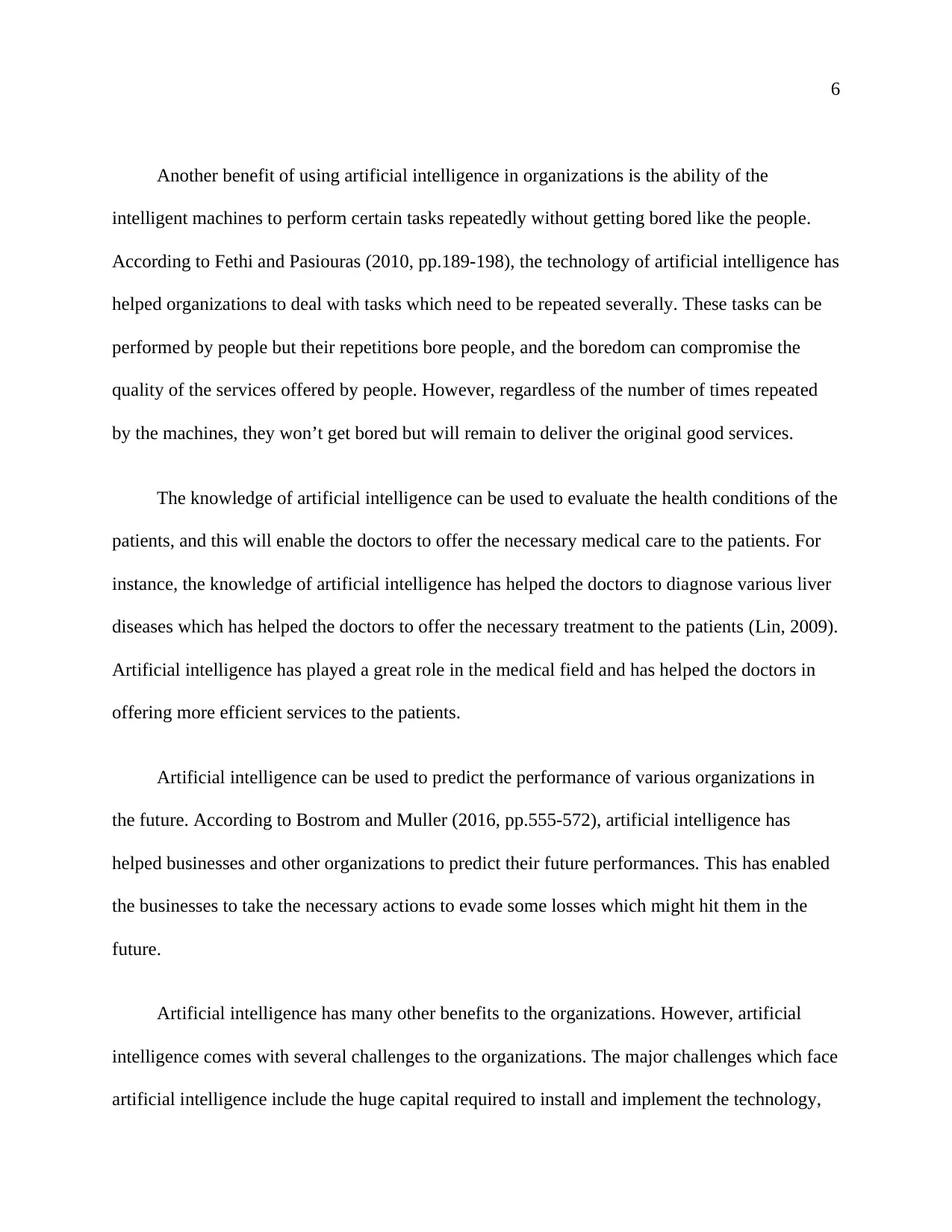
6
Another benefit of using artificial intelligence in organizations is the ability of the
intelligent machines to perform certain tasks repeatedly without getting bored like the people.
According to Fethi and Pasiouras (2010, pp.189-198), the technology of artificial intelligence has
helped organizations to deal with tasks which need to be repeated severally. These tasks can be
performed by people but their repetitions bore people, and the boredom can compromise the
quality of the services offered by people. However, regardless of the number of times repeated
by the machines, they won’t get bored but will remain to deliver the original good services.
The knowledge of artificial intelligence can be used to evaluate the health conditions of the
patients, and this will enable the doctors to offer the necessary medical care to the patients. For
instance, the knowledge of artificial intelligence has helped the doctors to diagnose various liver
diseases which has helped the doctors to offer the necessary treatment to the patients (Lin, 2009).
Artificial intelligence has played a great role in the medical field and has helped the doctors in
offering more efficient services to the patients.
Artificial intelligence can be used to predict the performance of various organizations in
the future. According to Bostrom and Muller (2016, pp.555-572), artificial intelligence has
helped businesses and other organizations to predict their future performances. This has enabled
the businesses to take the necessary actions to evade some losses which might hit them in the
future.
Artificial intelligence has many other benefits to the organizations. However, artificial
intelligence comes with several challenges to the organizations. The major challenges which face
artificial intelligence include the huge capital required to install and implement the technology,
Another benefit of using artificial intelligence in organizations is the ability of the
intelligent machines to perform certain tasks repeatedly without getting bored like the people.
According to Fethi and Pasiouras (2010, pp.189-198), the technology of artificial intelligence has
helped organizations to deal with tasks which need to be repeated severally. These tasks can be
performed by people but their repetitions bore people, and the boredom can compromise the
quality of the services offered by people. However, regardless of the number of times repeated
by the machines, they won’t get bored but will remain to deliver the original good services.
The knowledge of artificial intelligence can be used to evaluate the health conditions of the
patients, and this will enable the doctors to offer the necessary medical care to the patients. For
instance, the knowledge of artificial intelligence has helped the doctors to diagnose various liver
diseases which has helped the doctors to offer the necessary treatment to the patients (Lin, 2009).
Artificial intelligence has played a great role in the medical field and has helped the doctors in
offering more efficient services to the patients.
Artificial intelligence can be used to predict the performance of various organizations in
the future. According to Bostrom and Muller (2016, pp.555-572), artificial intelligence has
helped businesses and other organizations to predict their future performances. This has enabled
the businesses to take the necessary actions to evade some losses which might hit them in the
future.
Artificial intelligence has many other benefits to the organizations. However, artificial
intelligence comes with several challenges to the organizations. The major challenges which face
artificial intelligence include the huge capital required to install and implement the technology,
⊘ This is a preview!⊘
Do you want full access?
Subscribe today to unlock all pages.

Trusted by 1+ million students worldwide
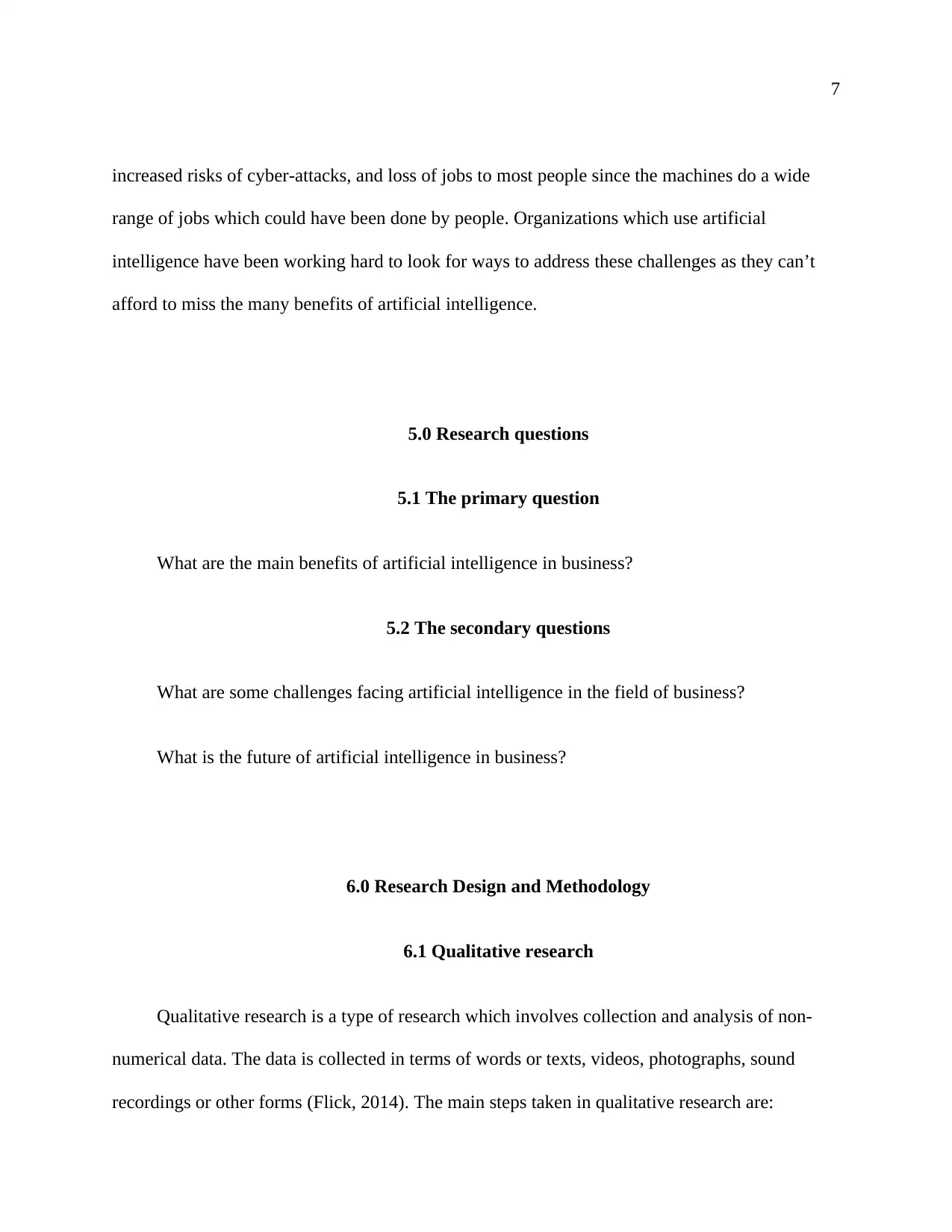
7
increased risks of cyber-attacks, and loss of jobs to most people since the machines do a wide
range of jobs which could have been done by people. Organizations which use artificial
intelligence have been working hard to look for ways to address these challenges as they can’t
afford to miss the many benefits of artificial intelligence.
5.0 Research questions
5.1 The primary question
What are the main benefits of artificial intelligence in business?
5.2 The secondary questions
What are some challenges facing artificial intelligence in the field of business?
What is the future of artificial intelligence in business?
6.0 Research Design and Methodology
6.1 Qualitative research
Qualitative research is a type of research which involves collection and analysis of non-
numerical data. The data is collected in terms of words or texts, videos, photographs, sound
recordings or other forms (Flick, 2014). The main steps taken in qualitative research are:
increased risks of cyber-attacks, and loss of jobs to most people since the machines do a wide
range of jobs which could have been done by people. Organizations which use artificial
intelligence have been working hard to look for ways to address these challenges as they can’t
afford to miss the many benefits of artificial intelligence.
5.0 Research questions
5.1 The primary question
What are the main benefits of artificial intelligence in business?
5.2 The secondary questions
What are some challenges facing artificial intelligence in the field of business?
What is the future of artificial intelligence in business?
6.0 Research Design and Methodology
6.1 Qualitative research
Qualitative research is a type of research which involves collection and analysis of non-
numerical data. The data is collected in terms of words or texts, videos, photographs, sound
recordings or other forms (Flick, 2014). The main steps taken in qualitative research are:
Paraphrase This Document
Need a fresh take? Get an instant paraphrase of this document with our AI Paraphraser
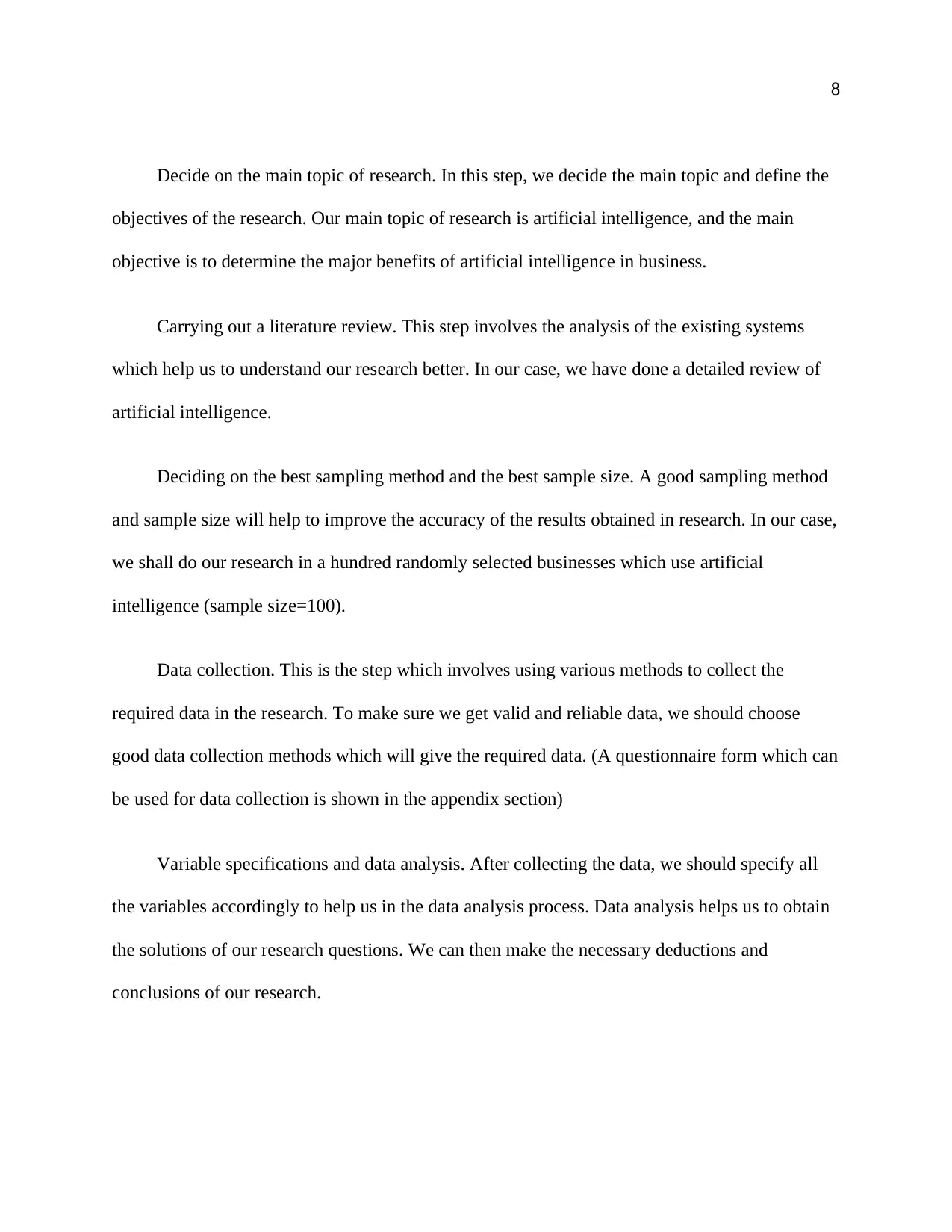
8
Decide on the main topic of research. In this step, we decide the main topic and define the
objectives of the research. Our main topic of research is artificial intelligence, and the main
objective is to determine the major benefits of artificial intelligence in business.
Carrying out a literature review. This step involves the analysis of the existing systems
which help us to understand our research better. In our case, we have done a detailed review of
artificial intelligence.
Deciding on the best sampling method and the best sample size. A good sampling method
and sample size will help to improve the accuracy of the results obtained in research. In our case,
we shall do our research in a hundred randomly selected businesses which use artificial
intelligence (sample size=100).
Data collection. This is the step which involves using various methods to collect the
required data in the research. To make sure we get valid and reliable data, we should choose
good data collection methods which will give the required data. (A questionnaire form which can
be used for data collection is shown in the appendix section)
Variable specifications and data analysis. After collecting the data, we should specify all
the variables accordingly to help us in the data analysis process. Data analysis helps us to obtain
the solutions of our research questions. We can then make the necessary deductions and
conclusions of our research.
Decide on the main topic of research. In this step, we decide the main topic and define the
objectives of the research. Our main topic of research is artificial intelligence, and the main
objective is to determine the major benefits of artificial intelligence in business.
Carrying out a literature review. This step involves the analysis of the existing systems
which help us to understand our research better. In our case, we have done a detailed review of
artificial intelligence.
Deciding on the best sampling method and the best sample size. A good sampling method
and sample size will help to improve the accuracy of the results obtained in research. In our case,
we shall do our research in a hundred randomly selected businesses which use artificial
intelligence (sample size=100).
Data collection. This is the step which involves using various methods to collect the
required data in the research. To make sure we get valid and reliable data, we should choose
good data collection methods which will give the required data. (A questionnaire form which can
be used for data collection is shown in the appendix section)
Variable specifications and data analysis. After collecting the data, we should specify all
the variables accordingly to help us in the data analysis process. Data analysis helps us to obtain
the solutions of our research questions. We can then make the necessary deductions and
conclusions of our research.
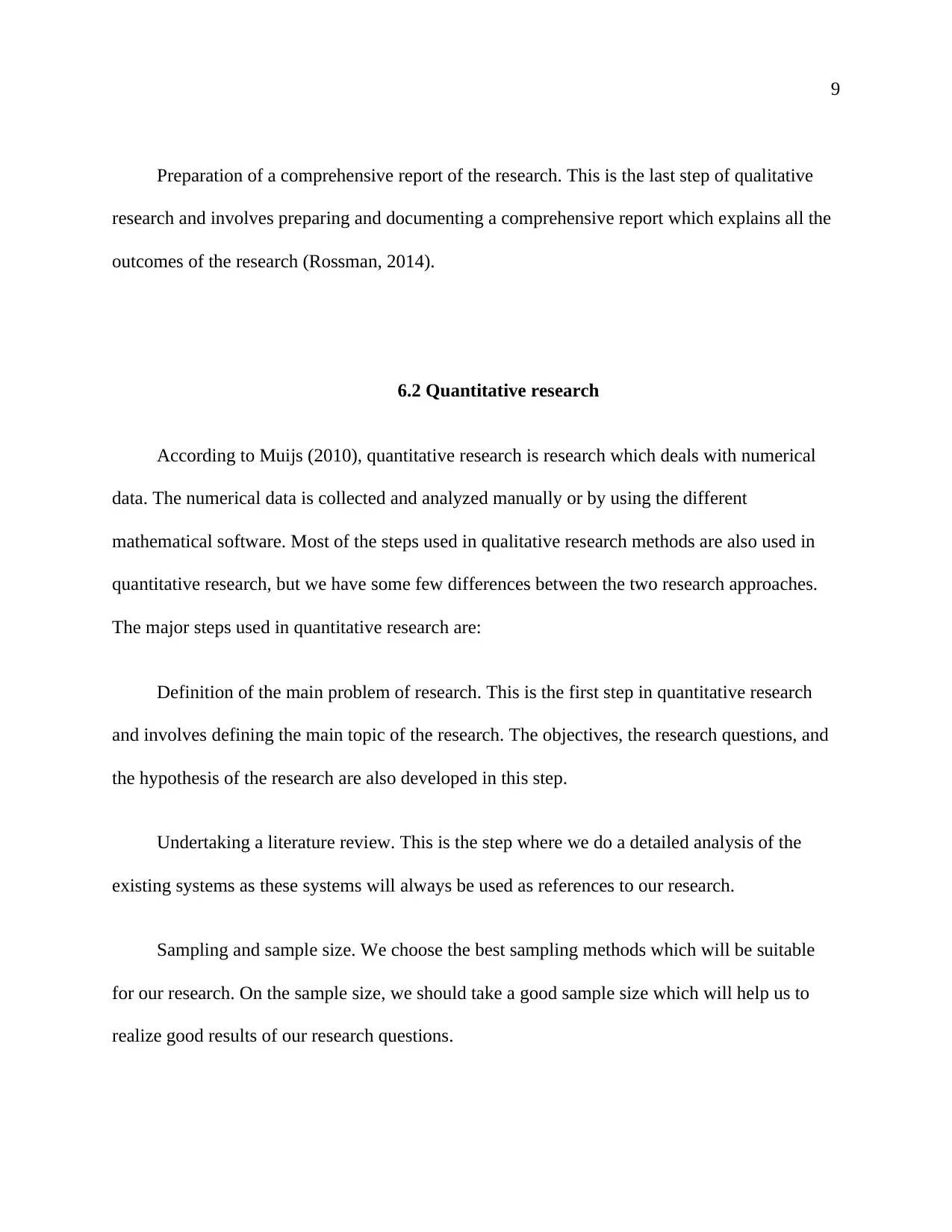
9
Preparation of a comprehensive report of the research. This is the last step of qualitative
research and involves preparing and documenting a comprehensive report which explains all the
outcomes of the research (Rossman, 2014).
6.2 Quantitative research
According to Muijs (2010), quantitative research is research which deals with numerical
data. The numerical data is collected and analyzed manually or by using the different
mathematical software. Most of the steps used in qualitative research methods are also used in
quantitative research, but we have some few differences between the two research approaches.
The major steps used in quantitative research are:
Definition of the main problem of research. This is the first step in quantitative research
and involves defining the main topic of the research. The objectives, the research questions, and
the hypothesis of the research are also developed in this step.
Undertaking a literature review. This is the step where we do a detailed analysis of the
existing systems as these systems will always be used as references to our research.
Sampling and sample size. We choose the best sampling methods which will be suitable
for our research. On the sample size, we should take a good sample size which will help us to
realize good results of our research questions.
Preparation of a comprehensive report of the research. This is the last step of qualitative
research and involves preparing and documenting a comprehensive report which explains all the
outcomes of the research (Rossman, 2014).
6.2 Quantitative research
According to Muijs (2010), quantitative research is research which deals with numerical
data. The numerical data is collected and analyzed manually or by using the different
mathematical software. Most of the steps used in qualitative research methods are also used in
quantitative research, but we have some few differences between the two research approaches.
The major steps used in quantitative research are:
Definition of the main problem of research. This is the first step in quantitative research
and involves defining the main topic of the research. The objectives, the research questions, and
the hypothesis of the research are also developed in this step.
Undertaking a literature review. This is the step where we do a detailed analysis of the
existing systems as these systems will always be used as references to our research.
Sampling and sample size. We choose the best sampling methods which will be suitable
for our research. On the sample size, we should take a good sample size which will help us to
realize good results of our research questions.
⊘ This is a preview!⊘
Do you want full access?
Subscribe today to unlock all pages.

Trusted by 1+ million students worldwide
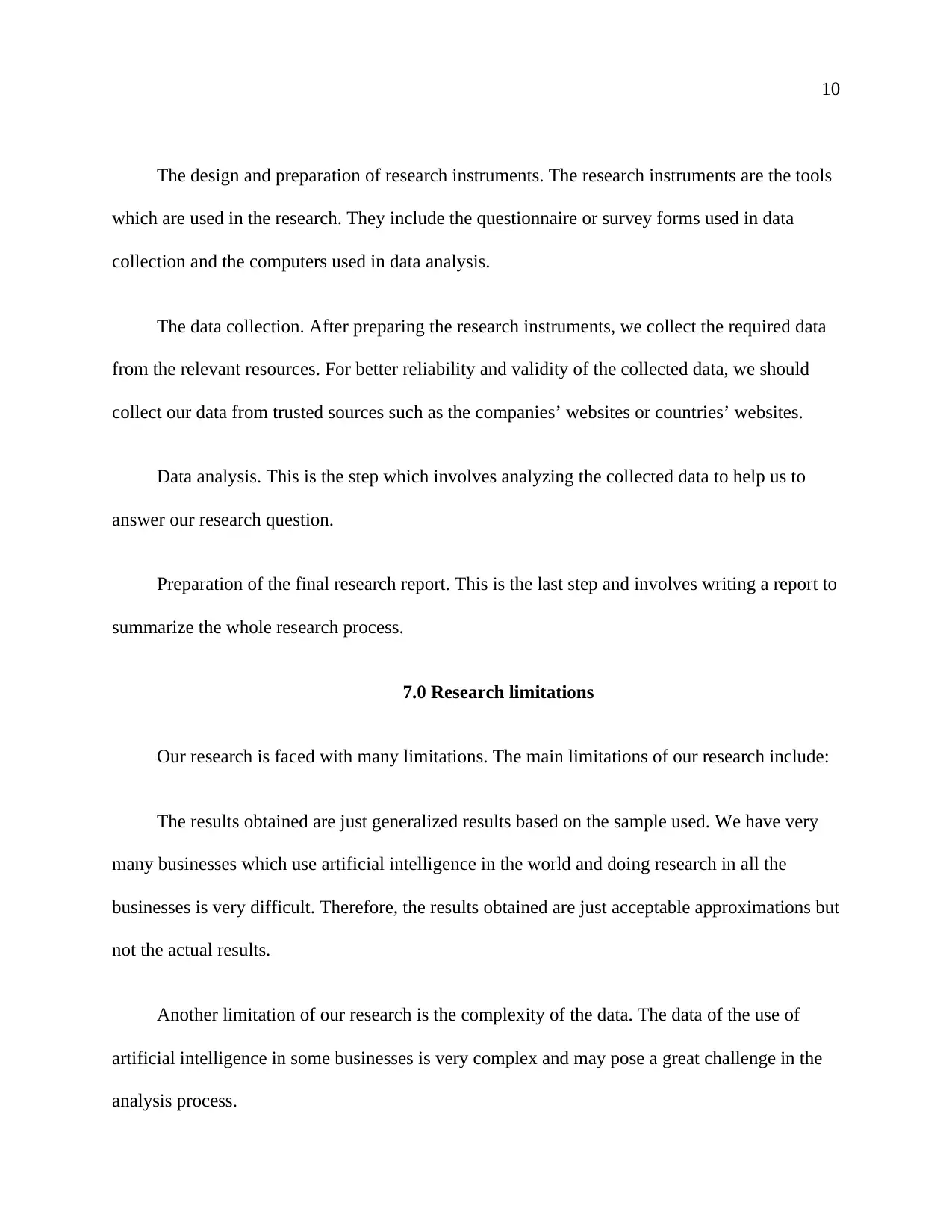
10
The design and preparation of research instruments. The research instruments are the tools
which are used in the research. They include the questionnaire or survey forms used in data
collection and the computers used in data analysis.
The data collection. After preparing the research instruments, we collect the required data
from the relevant resources. For better reliability and validity of the collected data, we should
collect our data from trusted sources such as the companies’ websites or countries’ websites.
Data analysis. This is the step which involves analyzing the collected data to help us to
answer our research question.
Preparation of the final research report. This is the last step and involves writing a report to
summarize the whole research process.
7.0 Research limitations
Our research is faced with many limitations. The main limitations of our research include:
The results obtained are just generalized results based on the sample used. We have very
many businesses which use artificial intelligence in the world and doing research in all the
businesses is very difficult. Therefore, the results obtained are just acceptable approximations but
not the actual results.
Another limitation of our research is the complexity of the data. The data of the use of
artificial intelligence in some businesses is very complex and may pose a great challenge in the
analysis process.
The design and preparation of research instruments. The research instruments are the tools
which are used in the research. They include the questionnaire or survey forms used in data
collection and the computers used in data analysis.
The data collection. After preparing the research instruments, we collect the required data
from the relevant resources. For better reliability and validity of the collected data, we should
collect our data from trusted sources such as the companies’ websites or countries’ websites.
Data analysis. This is the step which involves analyzing the collected data to help us to
answer our research question.
Preparation of the final research report. This is the last step and involves writing a report to
summarize the whole research process.
7.0 Research limitations
Our research is faced with many limitations. The main limitations of our research include:
The results obtained are just generalized results based on the sample used. We have very
many businesses which use artificial intelligence in the world and doing research in all the
businesses is very difficult. Therefore, the results obtained are just acceptable approximations but
not the actual results.
Another limitation of our research is the complexity of the data. The data of the use of
artificial intelligence in some businesses is very complex and may pose a great challenge in the
analysis process.
Paraphrase This Document
Need a fresh take? Get an instant paraphrase of this document with our AI Paraphraser
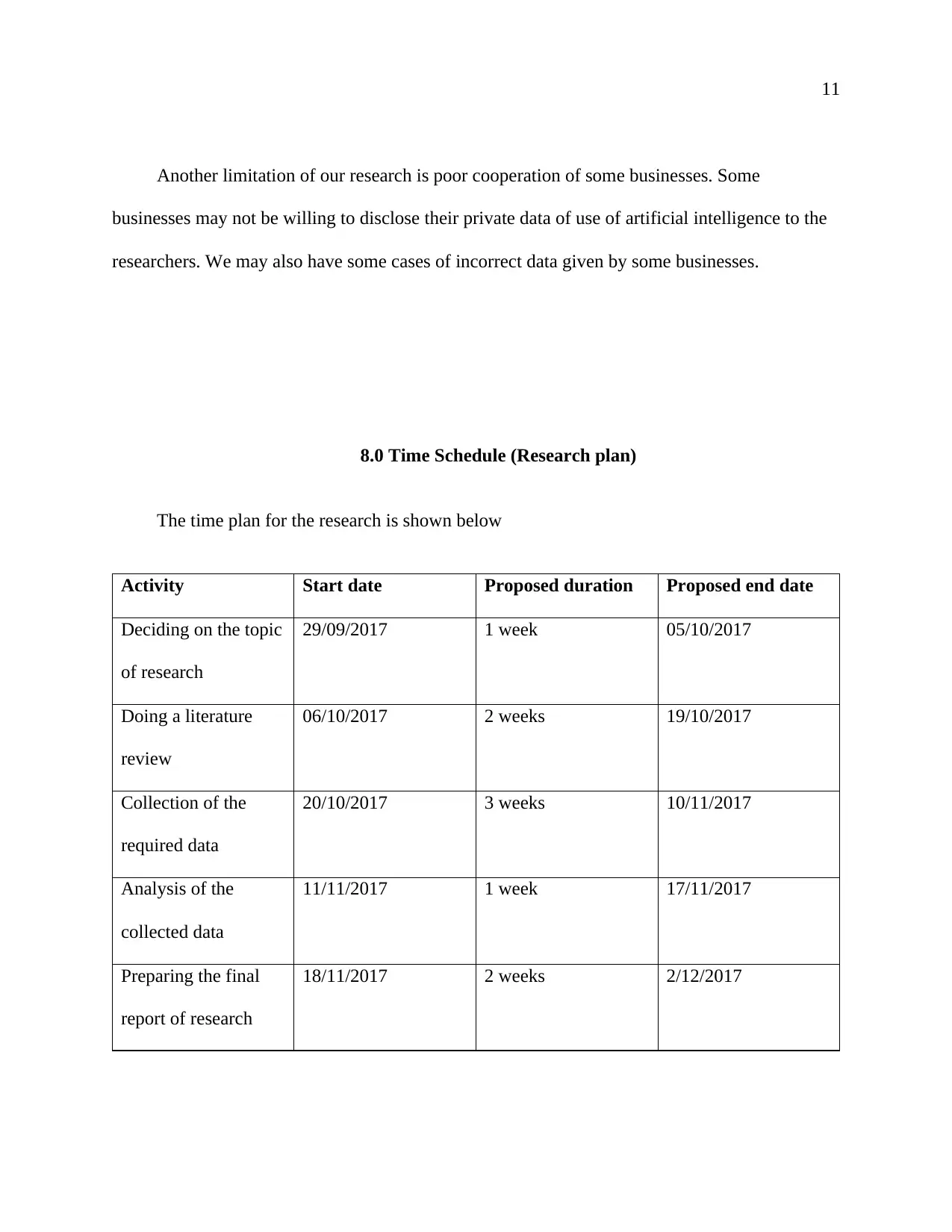
11
Another limitation of our research is poor cooperation of some businesses. Some
businesses may not be willing to disclose their private data of use of artificial intelligence to the
researchers. We may also have some cases of incorrect data given by some businesses.
8.0 Time Schedule (Research plan)
The time plan for the research is shown below
Activity Start date Proposed duration Proposed end date
Deciding on the topic
of research
29/09/2017 1 week 05/10/2017
Doing a literature
review
06/10/2017 2 weeks 19/10/2017
Collection of the
required data
20/10/2017 3 weeks 10/11/2017
Analysis of the
collected data
11/11/2017 1 week 17/11/2017
Preparing the final
report of research
18/11/2017 2 weeks 2/12/2017
Another limitation of our research is poor cooperation of some businesses. Some
businesses may not be willing to disclose their private data of use of artificial intelligence to the
researchers. We may also have some cases of incorrect data given by some businesses.
8.0 Time Schedule (Research plan)
The time plan for the research is shown below
Activity Start date Proposed duration Proposed end date
Deciding on the topic
of research
29/09/2017 1 week 05/10/2017
Doing a literature
review
06/10/2017 2 weeks 19/10/2017
Collection of the
required data
20/10/2017 3 weeks 10/11/2017
Analysis of the
collected data
11/11/2017 1 week 17/11/2017
Preparing the final
report of research
18/11/2017 2 weeks 2/12/2017
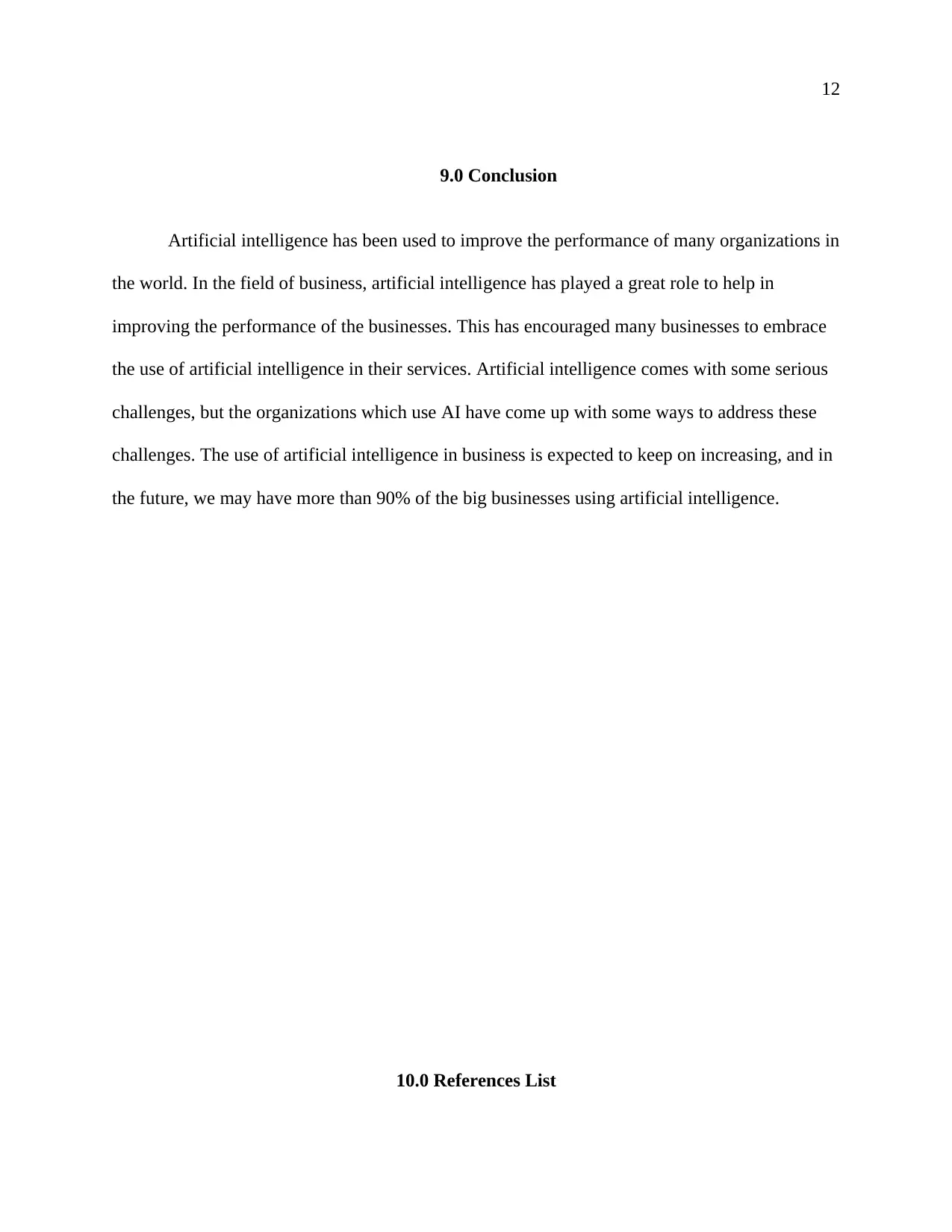
12
9.0 Conclusion
Artificial intelligence has been used to improve the performance of many organizations in
the world. In the field of business, artificial intelligence has played a great role to help in
improving the performance of the businesses. This has encouraged many businesses to embrace
the use of artificial intelligence in their services. Artificial intelligence comes with some serious
challenges, but the organizations which use AI have come up with some ways to address these
challenges. The use of artificial intelligence in business is expected to keep on increasing, and in
the future, we may have more than 90% of the big businesses using artificial intelligence.
10.0 References List
9.0 Conclusion
Artificial intelligence has been used to improve the performance of many organizations in
the world. In the field of business, artificial intelligence has played a great role to help in
improving the performance of the businesses. This has encouraged many businesses to embrace
the use of artificial intelligence in their services. Artificial intelligence comes with some serious
challenges, but the organizations which use AI have come up with some ways to address these
challenges. The use of artificial intelligence in business is expected to keep on increasing, and in
the future, we may have more than 90% of the big businesses using artificial intelligence.
10.0 References List
⊘ This is a preview!⊘
Do you want full access?
Subscribe today to unlock all pages.

Trusted by 1+ million students worldwide
1 out of 19
Related Documents
Your All-in-One AI-Powered Toolkit for Academic Success.
+13062052269
info@desklib.com
Available 24*7 on WhatsApp / Email
![[object Object]](/_next/static/media/star-bottom.7253800d.svg)
Unlock your academic potential
Copyright © 2020–2025 A2Z Services. All Rights Reserved. Developed and managed by ZUCOL.





